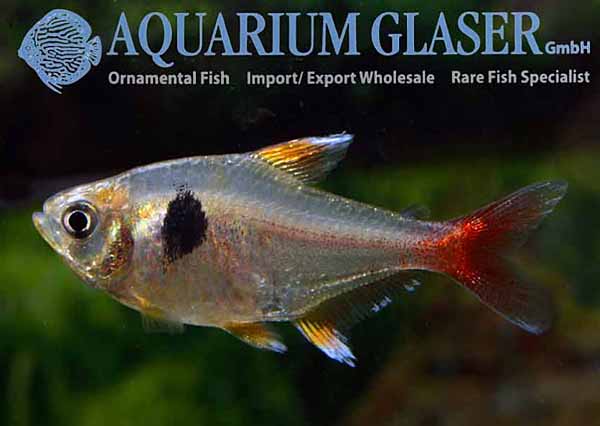Hyphessobrycon roseus
(Géry, 1960)
|
Familie: Characidae SynonymeMegalamphodus roseus Géry, 1960 Lokale Bezeichnung |
Typen
Holotypus: SMF 4784 .
Siehe: Eschmeyer, W.N., Fricke, R. & Van der Laan, R. (eds.) 2024. Catalog of Fishes electronic version
Typusfundort: Bäche bei Gaa Kaba, Maroni, Französisch-Guayana.
Etymologie
Roseus (= rosig), bezieht sich auf die "hellrosa" Körperfärbung. (Übersetzt aus: The ETYFish Project)
Verbreitung
Französisch-Guayana: Einzugsgebiete der Flüsse Maroni und Oyapock.
IUCN Status

EX Extinct (ausgestorben)
EW Extinct in the Wild (in der Natur ausgestorben)
CR Critically Endangered (vom Aussterben bedroht)EN Endangered (stark gefährdet)
VU Vulnerable (gefährdet)
NT Near Threatened (potenziell gefährdet)
LC Least Concern (nicht gefährdet)
RE Regionally Extinct (regional oder national ausgestorben)DD Data Deficient (ungenügende Datengrundlage)
NE Not Evaluated (nicht beurteilt)
Status: Stand 8.3.2022: NE Not Evaluated (nicht beurteilt)
Gefahren für diese Art: (nicht beurteilt)
Literatur
- Géry, J. 1960. Contributions to the study of the characoid fishes, No. 6. New Cheirodontinae from French Guiana. Senckenbergiana Biologica, 41 (1/2): 15–39, Pl. 2. Zitatseite [:26, Pl. 2 (fig. 3); Figs. 10-11, !!, als Megalamphodus roseus]
- Géry, J. 1977. Characoids of the World. T.F.H. Publications, Neptune City. 1-672. Zitatseite [:586, Beschreibung, Vorkommen ]
- Nieuwenhuizen, A.v.d. 1982. Hemigrammus erythrozonus, der Glühlichtsalmler. Die Aquarien- und Terrarienzeitschrift (DATZ), 35 (5): 161-164; Schluß: (6): 215-219. Zitatseite [:163*,Farbfoto ]
Die Aquarien- und Terrarienzeitschrift (DATZ)[1984/12:Titelbild]
NIEWENHUIZEN,A.van den: Phantomsalmler (Schluß). (DATZ 38 (1)1985:1-3)[:1-3, Aquarienhaltung, Fortpflanzung ]
Aquarien Terrarien[ 1989:189, Beschreibung ]
- Baensch, H.A. & Riehl, R. 1987. Aquarien Atlas, Band 2 (4. Auflage). Mergus-Verlag, Melle. Zitatseite [:282, Farbfoto, Kurztext]
FRANK,S.: Goldroter Schmuck im Aquarium - Der Gelbe Phantomsalmler Megalamphodus roseus (DA 270,Dezember 1991:14-15)[:14-15, Farbfoto, Fortpflanzung ]
- Géry, J., Planquette, P. & Le Bail, P.-Y. 1991. Faune characoïde (poissons ostariophysaires) de l'Oyapock, l'Approuague et la rivière de Kaw (Guyane Française). Cybium, 15 (1, suppl.): 1–69, Pls. 1–20. Zitatseite [:61|Vorkommen ]
SCHERF,T.: Der Gelbe Phantomsalmler - Megalamphodus roseus (DATZ 45(2)1992:97)[:97, Farbfoto, Fortpflanzung ]
VOIGT,W.: Phatomsalmler (Das Aquarium,297,3/1994:5-7)[:6, Farbfoto ]
NIEWENHUIZEN,A.van den: Ein Schmuckstück im Wohnzimmer: Megalamphodus roseus. (Aquar. Heute,14(4)1996:409-411)[:409ff, Farbfoto, Fortpflanzung, Aquarienhaltung ]
- Planquette, P., Keith, P. & Le Bail, P.-Y. 1996. Atlas des poissons d'eau douce de Guyane, Band 1. Muséum National d'Historie Naturelle, Ministère de l'Environnement, Paris. 429pp. Zitatseite [:332]
- Weitzman, S.H. & Palmer, L. 1997. A new species of Hyphessobrycon (Teleostei: Characidae) from the Neblina region of Venezuela and Brazil, with comments on the putative `rosy tetra clade'. Ichthyological Exploration of Freshwaters, 7 (3): 209-242. Zitatseite [:235, als Hyphessobrycon roseus]
- Weitzman, S.H. & Palmer, L. 1997. A new species of Hyphessobrycon (Teleostei: Characidae) from the Neblina region of Venezuela and Brazil, with comments on the putative `rosy tetra clade'. Ichthyological Exploration of Freshwaters, 7 (3): 209-242. Zitatseite [:235, Beschreibung, Synonyme ]
THIEL,W.: Phantomsalmler. (Aq. akt.,6/1997:54-56)[:56*, Farbfoto, Fortpflanzung, Aquarienhaltung ]
- Chevoleau, P. 2004. Storie di fantasmi, Megalamphodus megalopterus & C. Hydra, #29: 62-69. Zitatseite [:67*|Farbfoto ]
- Hoffmann, P. & Hoffmann, M. 2004. "Rosy Tetras". Die Aquarien- und Terrarienzeitschrift (DATZ), 57 (6): 6-13; (7): 6-11. Zitatseite [:12|Farbfoto, Beschreibung ]
- Hoffmann, P. & Hoffmann, M. 2004. "Rosy Tetras". Die Aquarien- und Terrarienzeitschrift (DATZ), 57 (6): 6-13; (7): 6-11. Zitatseite [:10|Farbfoto, cf. ]
- Staeck, W. 2005. Schwarz, rot, gelb: Phantomsalmler aus Südamerika. Aquaristik Aktuell, 14 (1) [2006]: 72-77. Zitatseite [:75f|Farbfoto, Vorkommen, Fortpflanzung, Aquarienhaltung ]
Körner, H.-J. (2006): Der Gelbe Phantomsalmler. Ein Name - zwei Arten. Aamazonas, 7, 2 (5): 88-91.[:88-91|Farbfoto, Beschreibung, zweiForm ]
- Bydzovský, V. 2007. Tricks und Tipps der tschechischen Aquarianer. Amazonas, 3 (2): 36-42. Zitatseite [:39|Fortpflanzung, Aquarienhaltung ]
- Xu, W., Lin, S. & Liu, H. 2021. Mitochondrial genomes of five Hyphessobrycon tetras and their phylogenetic implications. Ecology and Evolution, 11 (18): 12754-12764. (doi) Zitatseite [:, Genetik]
